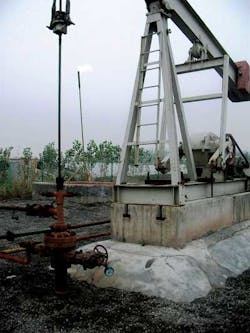Transaction trends in China
China requires oil to fuel its dramatic growth and is investing heavily overseas to assure a reliable supply.
Marcela Donadio and Raymond Ng, Ernst & Young, Houston
China has long been the world's most-populous country and the world's second-largest consumer of oil. In recent years, China's economy has boomed as the country has become more industrialized. With real gross domestic product growing at a rate of 8% to 10% a year, China's need for energy is projected to increase by 150% by 2020.
China's primary source of energy continues to be coal. However, to sustain growth, China requires increasing amounts of oil. Its rapidly rising demand and imports have made it a significant player in global oil markets. Consumption of natural gas has also increased rapidly in recent years as pipeline and liquefied natural gas (LNG) import infrastructure have been built.
Since 1980, Chinese oil consumption (including Hong Kong and Taiwan) has grown from just over two million barrels-per-day (MMb/d) to more than 10 MMb/d in 2010. Natural gas consumption in China has grown from about 575 billion cubic feet (bcf) in 1980 to almost 4.5 trillion cubic feet (tcf) in 2010.
But more critically, according to forecasts from the International Energy Agency (IEA), over the next 25 years, Chinese oil consumption is expected to almost double to more than 19 MMb/d, while natural gas consumption will increase by a factor of five, reaching to more than 22.4 tcf. Over the last 25 years, China has accounted for approximately 25% of the world's growth in oil demand and about 7% of the world's total natural gas demand growth.
Due to continued industrialization and the emergence of an increasingly energy-intensive middle class of consumers, China is expected to account for about 65% of the world's oil demand growth and about 30% of its natural gas demand growth over the next 25 years (to 2035).
Native, proven reserves are limited compared to consumption. As a result, China has steadily increased its import capacity over the past decade. More recently, it has formed partnerships or acquired interests in North American oil assets. For China, obviously, this provides an outlet for shoring up resources. For the partnering organizations, China provides much-needed access to capital for expansion.
The Chinese strategic response
During the period from 2006 to 2011:
• 11% of Chinese investments were domestic.
• 4% went toward regional assets in Asia.
• 85% of the total reported value went toward oil and gas assets outside of Asia.
Over the same period, Chinese companies executed more than 200 oil and gas transactions, with a total reported value of more than $135 billion. (Note that the Chinese total includes several volumetric production payment – VPP – transactions, essentially loans for future oil supply, which totaled $35 billion.) On a quarterly basis, activity was quite variable, with Chinese companies executing an average of 9 to 10 transactions per quarter.
The Chinese external oil and gas investments were relatively diversified but were dominated by investments in the Former Soviet Union (FSU), primarily Kazakhstan and Russia.; North and South America, mainly Brazil but also Venezuela; and in Africa, chiefly Sudan and Angola.
North American investments have been less in total, but are becoming somewhat more frequent. To date, these investments have primarily been in Canadian oil sands and, more recently, in US shale gas, most notably a joint venture between CNOOC and Chesapeake Energy, involving a one-third interest in Chesapeake's Eagle Ford shale gas/liquids play. A large proposed JV in Canadian unconventional gas (tight gas rather than shale) between PetroChina and EnCana failed to move to closing and was abandoned.
However, the historical deal statistics likely understate the Chinese interest in US unconventional gas/liquids development as well as the interest of many US companies in the potential investment in their resources activities as a liquidity source, given the low current and expected gas price levels.
Chinese oil and gas investments have been further dominated by upstream transactions, with deals for upstream reserves and production accounting for 79% of the total deal value, and deals involving upstream acreage accounting for another 3%. Downstream transactions accounted for about 14% of the total reported value, with oilfield services deals accounting for another 3%.
From an upstream "play" perspective, the Chinese investments were similarly diverse but were dominated by the VPP transactions, followed by conventional asset transactions, and then by diversified and deepwater transactions.
Partners, competitors and customers: the implications for oil and gas companies
What does the emergence of China as an energy giant mean for non-Chinese oil and gas companies, and what opportunities and challenges does it present? In short, oil and natural gas companies need to see their Chinese counterparts from three distinct perspectives: as potential partners, competitors, and customers.
In the Americas, oil and gas companies will primarily see Chinese companies as potential partners, particularly with the Chinese NOCs willing to invest to secure long-term oil supplies (such as from Canadian oil sands or Brazilian deepwater) or to secure access to specific technology (such as US shale gas technology and experience) that can be leveraged to develop a potentially large domestic resources in China.
For many companies, Chinese investments could provide some much-needed operating capital for cash-strapped developments, given the relatively low North American gas prices. In most cases, the Chinese investments will be welcomed. While there is some lingering US political sensitivity to foreign ownership of energy assets, JVs largely are seen as acceptable. For example, contrast the controversy around the proposed Unocal deal in 2005 with the lack of controversy around the recent Chesapeake deal.
However, in other cases, the Chinese NOCs may aggressively compete for assets with regional companies and international oil companies (IOCs), with the Chinese NOCs having distinct competitive advantages in financing and political leverage in many cases.
In other regions, Chinese companies will be viewed as upstream competitors to the non-Chinese companies, but occasionally they will be seen as partners, particularly with certain regional specialists. Investments and partnerships around LNG development and supply are also very likely, not only in other southeastern Asian countries, Australia, Africa, the Middle East, and Russia, but also in the Americas (e.g., Peru, Venezuela, and potentially the US and Canada).
Coalbed methane well in Jiaozou area in China's Henan Province.
In the downstream sector, there may be some opportunities with potential Chinese acquisitions of downstream stakes to bolster trading and arbitrage opportunities, such as the recent European refining acquisition in which PetroChina took a 50% interest in two Ineos Group refineries in Scotland and France as part of an oil trading JV. Quite obviously however, these downstream investments would be in direct competition with other refiners.
In China itself, non-Chinese upstream companies will find their partnership opportunities somewhat more limited, typically only available to the larger, integrated and/or specialized IOCs. However, unconventional gas development in China, both in terms of shale and coal seam gas, could become open to partnership opportunities for smaller, but again, specialized IOCs.
With unconventional gas development in China, oilfield services comp-anies should see a substantial increase in demand for services. The current Chinese OFS industry will likely need outside help as service requirements are significantly higher for unconventionals.
An unconventional boom in China will come with challenges – potential tightness in equipment and skilled labor as activity ramps up, as well as supply-chain challenges. The large, diversified OFS companies, with well-established supply chains, will be well-positioned to support an unconventionals boom in China. But there will also be room for smaller, specialized OFS companies looking to grow internationally.
In the Chinese downstream, some investment opportunities for new refining and chemical capacity will be available to the large IOCs with critical project management skills, with those deals also possibly tied to long-term crude supply arrangements. New creative partnership models may also emerge, such as the recent JV between BG Group and the Bank of China.
Overall, all segments of the industry will be impacted by China's increasing need to obtain energy resources. And while the opportunities may be great, so will the challenges. It will be those companies that can navigate the obstacles that will reap the greatest reward. OGFJ
About the authors
Raymond Ng is China Oil & Gas Leader for Ernst & Young.
More Oil & Gas Financial Journal Current Issue Articles
More Oil & Gas Financial Journal Archives Issue Articles
View Oil and Gas Articles on PennEnergy.com




